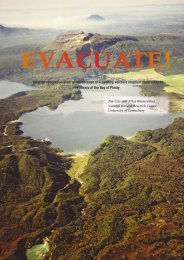Volcanoes - Ministry of Civil Defence and Emergency Management
Volcanoes - Ministry of Civil Defence and Emergency Management
Volcanoes - Ministry of Civil Defence and Emergency Management
Create successful ePaper yourself
Turn your PDF publications into a flip-book with our unique Google optimized e-Paper software.
mountain in their backyard’ will ever erupt again. This<br />
denial limits the amount <strong>of</strong> information residents are<br />
willing to take in when presented with it, as they do<br />
not acknowledge its necessity.<br />
MT. RUAPEHU<br />
Mt. Ruapehu has been active <strong>and</strong> generated<br />
major hazard events within living memory <strong>of</strong> most<br />
New Zeal<strong>and</strong>ers. In 1945, explosive eruptions spread<br />
volcanic ash from Wellington to the Bay <strong>of</strong> Plenty. Eight<br />
years later the Crater Lake, which had filled to a level<br />
8m above the pre-1945 level, collapsed, rapidly sending<br />
1,650,000 m 3 <strong>of</strong> water down the Whangaehu River.<br />
Through entraining debris down the river, a substantial<br />
lahar was formed. Reaching its peak discharge 42 km<br />
downstream at Tangiwai the lahar took out the rail<br />
bridge, just before the Wellington-Auckl<strong>and</strong> passenger<br />
train crossed it, killing 151 people.<br />
Further hazardous lahars, caused by the<br />
displacement <strong>of</strong> Crater Lake water in 1969, 1971 <strong>and</strong><br />
1975, flowed north down the Whakapapa skifield <strong>and</strong><br />
south down the Whangaehu River, with two <strong>of</strong> these<br />
events causing extensive damage to skifield facilities<br />
<strong>and</strong> to alpine huts. In September 1995, the volcano<br />
produced numerous lahars, one <strong>of</strong> which flowed<br />
down the Whakapapa Skifield minutes after closing<br />
time. Eruptions in 1995 <strong>and</strong> 1996 also spread ash from<br />
Auckl<strong>and</strong> to Hawke’s Bay.<br />
Risk perception <strong>and</strong> underst<strong>and</strong>ing <strong>of</strong> volcanic<br />
hazards was examined by Johnston <strong>and</strong> others (1999) in<br />
two communities (Whakatane <strong>and</strong> Hastings) both before<br />
<strong>and</strong> after the Mt. Ruapehu eruptions <strong>of</strong> September-<br />
October 1995. While both communities received intense<br />
media coverage <strong>of</strong> the eruption, only Hastings directly<br />
experienced the eruption in the form <strong>of</strong> ashfalls. The<br />
change found in risk perceptions between the two<br />
communities as a result <strong>of</strong> the 1995 eruption was<br />
interesting.<br />
In Whakatane, prior to the 1995 eruption,<br />
volcanic eruptions were thought to have a possible<br />
moderate impact on personal safety. Following the<br />
eruptions there was little change to this perception.<br />
However, Hastings residents who were surveyed thought<br />
prior to the 1995 eruption that volcanic eruptions were<br />
unlikely to threaten their personal safety <strong>and</strong> continued<br />
to think this, although slightly less so, after being<br />
subjected to ashfalls from the eruption. In regard to the<br />
perceived ability <strong>of</strong> volcanic eruptions to disrupt daily<br />
life, Whakatane respondents felt disruption was ‘likely’<br />
both before <strong>and</strong> after the eruption. Hastings respondents<br />
changed their opinion from ‘unlikely’ before the<br />
eruption to close to neutral after the eruption. When<br />
asked if the eruption had changed their view <strong>of</strong> potential<br />
volcanic hazards in their region, 45% <strong>of</strong> Whakatane<br />
respondents claimed that the eruption had, compared<br />
with 61% <strong>of</strong> Hastings respondents. The main agents<br />
for change in perceptions were social sources, such as<br />
newsmedia <strong>and</strong> authorities (eg. <strong>Civil</strong> <strong>Defence</strong>, GNS) for<br />
Whakatane respondents <strong>and</strong> personal experience for<br />
Hastings respondents. So, although the direct effect <strong>of</strong><br />
the 1995 eruption <strong>of</strong> Mt. Ruapehu did enhance Hastings<br />
residents’ threat knowledge <strong>and</strong> risk perception,<br />
Whakatane residents still perceived a higher risk from<br />
volcanic eruptions.<br />
Perceived level <strong>of</strong> preparedness was also reported<br />
on. Before the eruption, 66% <strong>of</strong> Whakatane respondents<br />
claimed to have undertaken protective measures, this<br />
figure remaining unchanged after the eruption. 63%<br />
<strong>of</strong> Hastings respondents claimed to have undertaken<br />
protective measures prior to the eruption, dropping to<br />
53% following the eruption, showing that increased<br />
risk perception does not necessarily lead to better<br />
preparedness.<br />
The perceived change in improved preparedness<br />
across central government, local government, the<br />
community <strong>and</strong> individuals was also examined.<br />
Whakatane respondents reported a significant perceived<br />
improvement in central government preparedness<br />
following the eruption, whereas Hastings respondents<br />
reported significant improvement in preparedness across<br />
all groups. The increased risk perception in Hastings<br />
respondents, combined with a reduction in preparedness<br />
activities <strong>and</strong> general increase in perceived preparedness<br />
suggests that the relatively benign effect <strong>of</strong> the eruption<br />
led to normalisation bias (where people experience a<br />
rare, minor event <strong>and</strong> extrapolate that they can deal<br />
with more serious consequences) in Hastings residents.<br />
More recently, studies by Galley <strong>and</strong> others<br />
(2003) <strong>and</strong> Leonard <strong>and</strong> others (2004) have investigated<br />
public risk perceptions at Whakapapa ski area in<br />
conjunction with testing the effectiveness <strong>of</strong> the<br />
Eruption Detection System (EDS). In both studies, nearly<br />
all respondents knew that Mt. Ruapehu is an active<br />
volcano (96% in 2000 <strong>and</strong> 94% in 2003). The correct<br />
timing <strong>of</strong> the next eruption likely to affect the ski area<br />
(within the next 10 years) increased significantly from<br />
48% in 2000 to 59% in 2003, possibly due to increased<br />
uptake <strong>of</strong> information presented at the Department <strong>of</strong><br />
Conservation (DoC) information centre in Whakapapa<br />
Village. Although a majority <strong>of</strong> respondents had a<br />
good <strong>and</strong> increased knowledge that the ski area will be<br />
closed in the event <strong>of</strong> hazards such as lahars, lava flows,<br />
volcanic bombs, gas <strong>and</strong> ash (each over 60% in 2000<br />
<strong>and</strong> 76% in 2003), the awareness <strong>of</strong> lahar danger zones<br />
on the ski area was relatively low <strong>and</strong> decreased. In<br />
2000, 21% <strong>of</strong> respondents knew all the danger zones,<br />
28% knew some, <strong>and</strong> 52% knew none. In 2003, this<br />
dropped to 5% <strong>of</strong> respondents knowing all the danger<br />
63<br />
TEPHRA<br />
June 2004

















